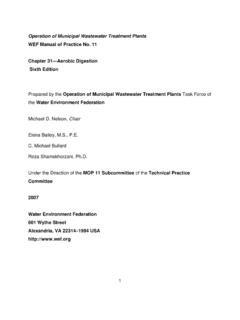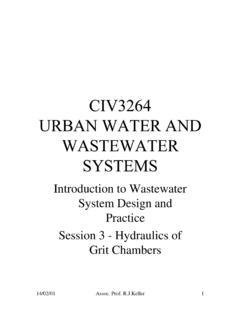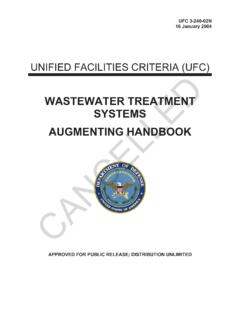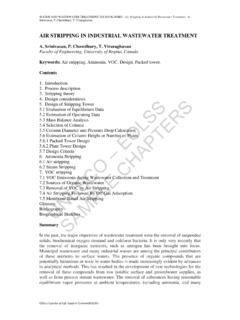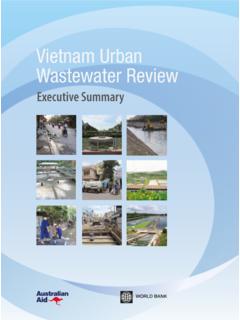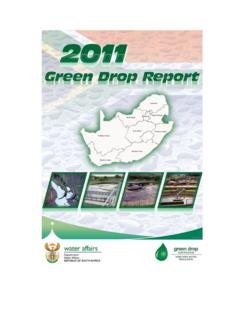Transcription of Operation of Municipal Wastewater Treatment Plants
1 1 Operation of Municipal Wastewater Treatment Plants WEF Manual of Practice No. 11 Chapter 33 Dewatering Sixth Edition Prepared by the Operation of Municipal Wastewater Treatment Plants Task Force of the Water Environment Federation Michael D. Nelson, Chair John F. Austin, C. Michael Bullard, Charles A. Fagan, II, Peter L. LaMontagne, Wayne Laraway Under the Direction of the MOP 11 Subcommittee of the Technical Practice Committee 2007 Water Environment Federation 601 Wythe Street Alexandria, VA 22314 1994 USA 2 About WEF Formed in 1928, the Water Environment Federation (WEF) is a not-for-profit technical and educational organization with 32,000 individual members and 80 affiliated Member Associations representing an additional 50,000 water quality professionals throughout the world. WEF and its member associations proudly work to achieve our mission of preserving and enhancing the global water environment.
2 For information on membership, publications, and conferences, contact Water Environment Federation 601 Wythe Street Alexandria, VA 22314-1994 USA (703) 684-2400 IMPORTANT NOTICE The material presented in this publication has been prepared in accordance with generally recognized engineering principles and practices and is for general information only. This information should not be used without first securing competent advice with respect to its suitability for any general or specific application. The contents of this publication are not intended to be a standard of the Water Environment Federation (WEF) and are not intended for use as a reference in purchase specifications, contracts, regulations, statutes, or any other legal document. No reference made in this publication to any specific method, product, process, or service constitutes or implies an endorsement, recommendation, or warranty thereof by WEF.
3 WEF makes no representation or warranty of any kind, whether expressed or 3 implied, concerning the accuracy, product, or process discussed in this publication and assumes no liability. Anyone using this information assumes all liability arising from such use, including but not limited to infringement of any patent or patents. Copyright 2007 by the Water Environment Federation All Rights Reserved. Water Environment Research, WEF, and WEFTEC are registered trademarks of the Water Environment Manuals of Practice of the Water Environment Federation The WEF Technical Practice Committee (formerly the Committee on Sewage and Industrial Wastes Practice of the Federation of Sewage and Industrial Wastes Associations) was created by the Federation Board of Control on October 11, 1941. The primary function of the Committee is to originate and produce, through appropriate subcommittees, special publications dealing with technical aspects of the broad interests of the Federation.
4 These publications are intended to provide background information through a review of technical practices and detailed procedures that research and experience have shown to be functional and practical. Water Environment Federation Technical Practice Committee Control Group B. G. Jones, Chair J. A. Brown, Vice-Chair S. Biesterfeld-Innerebner R. Fernandez S. S. Jeyanayagam Z. Li M. D. Nelson S. Rangarajan E. P. Rothstein A. T. Sandy A. K. Umble T. O. Williams J. Witherspoon 5 Contents Chapter 33 Dewatering Introduction What Makes Biosolids Difficult to Dewater? Difficulty in Dewatering Biosolids Free Water Bound Water Vicinal Water Interstitial Water Capillary Water Improving the Quality of Biosolids Tracking Down the Cause of a Change Thinking Ahead.
5 Inorganic Chemical Addition to Achieve Class A Biosolids Limit Before Dewatering Limit After Dewatering Safety Obtaining Help Knowledgeable Experts Suppliers Water Environment Federation Environmental Protection Agency Operating Principles for Dewatering Management of Information 6 Changing Values Inorganic Chemical Addition Ferric Chloride and Alum Struvite Control Odor Control Chemicals Buying Chemicals Organic Flocculants Background Polymer Characteristics Electronic Charge (Type) Charge Density Molecular Weight Polymer Forms and Storage and Handling Dry Polyacrylamide Emulsion Polyacrylamide Solution Polyacrylamide General Safety Polymer Specifications and Quality Control Active Polymer Content Charge Density Standard Viscosity Product Make-Down Dry Polyacrylamide 7 Emulsion
6 Polyacrylamide Polymer Degradation Sludge Conditioning Performance Optimization (Dewatering) Cost of Polymer Cost of Sludge Disposal or Downstream Processing Cost of Recycle (Capture) Throughput (Feed Rate) Automation Polymer Selection Outline for Conducting Effective Polymer Evaluations and Product Selection Case Histories Trial Conditions (Sludge and Equipment Management) Barge Transfers of Sludge Managing In-Plant Sludge Transfers Managing Sludge Transfers from Digesters Equipment and Design Limitations Equipment Limitations Trial Management Real-Time Analyses and Data Manipulation of Trial Design Trial Management (Sludge Manipulation) 8 Trial Management (Sampling and Analysis) Trial Management (Sampling)
7 Conclusion Air-Drying Biosolids Principles of Operation Reed Beds Sand Beds Vacuum-Assisted Drainage Beds Paved Beds Paved Beds with Sand Drains Process Variables Feed Solids Type and Quality System Design Chemical Conditioning Process Control Reed Beds Troubleshooting Sand Beds and Paved Beds Sand Beds Vacuum-Assisted Drying Beds Mechanical Dewatering Equipment General Dewatering Capability of Dewatering Equipment Installation Considerations 9 Biosolids Feed-Pump Considerations Conveyance of Dewatered Biosolids Additives General Calculations for Mechanical Dewatering Nomenclature Polymer Dosage Belt Filter Press Principles of Operation Process Variables Biosolids Type and Quality Polymer Activity Polymer Addition and Mixing Cake Dryness Polymer Type and Dosage Hydraulic Loading
8 Solids Loading Capture Mechanical Variables Sequence of Operation Belt Filter Press Optimization and Troubleshooting Low Cake Solids Low Capture Rates Low Solids Loading 10 Maintenance Safety Considerations Dewatering Centrifuges Principles of Operation Math Specific to Centrifuges Process Variables Biosolids Type and Quality Polymer Activity and Mixing with the Biosolids Cake Dryness Polymer Type and Dosage Performance Level Differential Speed Scroll Torque Torque Control Bowl Speed Weir Setting Polymer Addition Point Operation Sequence of Operation Centrifuge Data Sheet Temperature Effects Process
9 Control Troubleshooting Obtaining Dryer Cakes 11 Reducing the Polymer Consumption Increasing Capacity Vacuum and Pressure Filters Inorganic Chemical Conditioning Lime Dosage Requirements Other Types of Conditioners Pressure Filters Principles of Operation Principles of Conditioning Inorganic Chemical Conditioning Ferric Salts Lime Process Variables Chemical Conditioning Process Control Troubleshooting Startup and Shutdown Procedures Safety Concerns Maintenance Considerations
10 Vacuum Filters Principles of Operation Process Variables Preventive Maintenance 12 Lubrication Bearings Repairs Dealing with the Repair Shop Data Collection and Laboratory Control Safety and Housekeeping References 13 LIST OF FIGURES Figure Page Figure Typical points of addition of organic flocculants in Wastewater Treatment Figure Typical Wastewater Treatment flow diagram Figure Types of organic flocculants according to electronic charge density and molecular weight Figure Dose-response curve of manipulated trial data Figure Typical dose response curves Figure Reed harvesting in the spring Figure Sand bed details Figure Plant view of a vacuum-assisted drying bed system Figure Cross-section of a wedge-wire drying bed Figure Paved beds Figure Filtration process Figure Belt filter press process flow diagram Figure Centrifuge cutaway Figure Centrifuge disassembly Figure Differential head pressure Figure Plate and frame press Figure Fixed-volume recessed plate filter press 14 Figure Fixed-volume recessed plate filter press Figure Plate drainage holes behind cloth on fixed-volume recessed plate filter press Figure Schematic of
